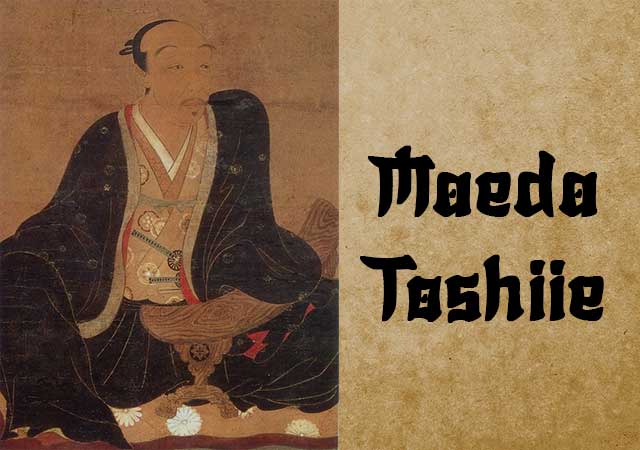
Maeda Toshiie stood as a pivotal and accomplished figure during the Warring States Period, leaving an indelible mark on history. Born in Arako on January 15, 1538, to Maeda Toshimasa, the lord of Arako Castle in Owari (now part of Nagoya City, Aichi Prefecture), Toshiie, also known as Inuchiyo or Matazaemon, emerged from a distinguished lineage.
In his youth, Toshiie served as a page to Oda Nobunaga, forging a close friendship with the spirited and unconventional Nobunaga. Notably, he earned the moniker "Yari-no-Mataza" for his exceptional spear skills. Despite having four older brothers, Toshiie was appointed as the head of the Maeda clan at the behest of Nobunaga in 1560 after his father's passing.
Toshiie played key roles in Nobunaga's forces, serving in the Akahoro-shu and later as the Ashigaru-Taisho. His valor shone in battles, particularly under Shibata Katsuie against the Asakura clan. For his achievements, he was granted the lucrative domain of Kaga (Kanazawa), making it the wealthiest domain of the Edo period.
Following Nobunaga's demise, Toshiie found himself pitted against his friend Toyotomi Hideyoshi in the Battle of Shizugatake, fighting under Shibata's banner. Subsequently, he became a general in Hideyoshi's army and faced another friend, Sassa Narimasa, at the Siege of Suemori Castle in 1584.
Appointed to the Council of Five Elders by Hideyoshi, Toshiie played a crucial role in governing on behalf of Hideyoshi's son, Hideyori. At Hideyoshi's deathbed in 1598, Toshiie received the solemn duty of directly caring for the infant Hideyori.
In opposition to Ieyasu's actions after Hideyoshi's death, Toshiie passed away at the age of 61 on April 27, 1599, a year before the Battle of Sekigahara. His wife, Matsu, a woman of both literary and martial prowess, played a significant role in Toshiie's ascent to power. Together, they had ten children, and Matsu's intelligence and strong will ensured the survival and prosperity of the Maeda clan. After Toshiie's demise and the Battle of Sekigahara, Matsu voluntarily became a hostage at Edo Castle, safeguarding the Maeda clan's legacy throughout the Edo period and beyond.
See also
-
Yamagata Masakage

Masakage was one of Takeda Shingen’s most loyal and capable commanders. He was included in the famous list of the “Twenty-Four Generals of Takeda Shingen” and also belonged to the inner circle of four especially trusted warlords known as the Shitennō.
-
Yagyu Munenori

Yagyū Munenori began his service under Tokugawa Ieyasu while his father, Yagyū Muneyoshi, was still at his side. In 1600, Munenori took part in the decisive Battle of Sekigahara. As early as 1601, he was appointed a kenjutsu instructor to Tokugawa Hidetada, Ieyasu’s son, who later became the second shogun of the Tokugawa clan.
-
Yagyu Muneyoshi

A samurai from Yamato Province, he was born into a family that had been defeated in its struggle against the Tsutsui clan. Muneyoshi first took part in battle at the age of sixteen. Due to circumstances beyond his control, he was forced to enter the service of the Tsutsui house and later served Miyoshi Tōkei. He subsequently came under the command of Matsunaga Hisahide and in time became a vassal first of Oda and later of Toyotomi.
-
Endo Naozune

Naozune served under Azai Nagamasa and was one of the clan’s leading vassals, renowned for his bravery and determination. He accompanied Nagamasa during his first meeting with Oda Nobunaga and at that time asked for permission to kill Nobunaga, fearing him as an extremely dangerous man; however, Nagamasa did not grant this request.
-
Hosokawa Sumimoto

Sumimoto came from the Hosokawa clan: he was the biological son of Hosokawa Yoshiharu and at the same time the adopted son of Hosokawa Masamoto, the heir of Hosokawa Katsumoto, one of the principal instigators of the Ōnin War. Masamoto was homosexual, never married, and had no children of his own. At first he adopted Sumiyuki, a scion of the aristocratic Kujō family, but this choice provoked dissatisfaction and sharp criticism from the senior vassals of the Hosokawa house. As a result, Masamoto changed his decision and proclaimed Sumimoto as his heir, a representative of a collateral branch of the Hosokawa clan that had long been based in Awa Province on the island of Shikoku. Almost immediately after this, the boy became entangled in a complex and bitter web of political intrigue.
-
Honda Masanobu

Masanobu initially belonged to the retinue of Tokugawa Ieyasu, but later entered the service of Sakai Shōgen, a daimyo and priest from Ueno. This shift automatically made him an enemy of Ieyasu, who was engaged in conflict with the Ikkō-ikki movement in Mikawa Province. After the Ikkō-ikki were defeated in 1564, Masanobu was forced to flee, but in time he returned and once again entered Ieyasu’s service. He did not gain fame as a military commander due to a wound sustained in his youth; nevertheless, over the following fifty years he consistently remained loyal to Ieyasu.
-
Honda Masazumi

Masazumi was the eldest son of Honda Masanobu. From a young age, he served Tokugawa Ieyasu alongside his father, taking part in the affairs of the Tokugawa house and gradually gaining experience in both military and administrative matters. At the decisive Battle of Sekigahara in 1600, Masazumi was part of the core Tokugawa forces, a clear sign of the high level of trust Ieyasu placed in him. After the campaign ended, he was given a highly sensitive assignment—serving in the guard of the defeated Ishida Mitsunari, one of Tokugawa’s principal enemies—an obligation that required exceptional reliability and caution.
-
Hojo Shigetoki

Hōjō Shigetoki, the third son of Hōjō Yoshitoki, was still very young—only five years old—when his grandfather Tokimasa became the first member of the Hōjō clan to assume the position of shogunal regent.

